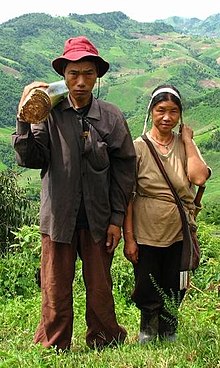Humankind
| Human Temporal range: 0.195–0 Ma – Recent |
|
|---|---|
 |
|
| An adult human male (left) and female (right) in Northern Thailand. | |
| Scientific classification | |
| Kingdom: | Animalia |
| Phylum: | Chordata |
| Class: | Mammalia |
| Order: | Primates |
| Suborder: | Haplorhini |
| Family: | Hominidae |
| Genus: | Homo |
| Species: | H. sapiens |
| Binomial name | |
|
Homo sapiens Linnaeus, 1758 |
|
| Subspecies | |
|
†Homo sapiens idaltu White et al., 2003 |
|
 |
|
| Homo sapiens population density | |
| Synonyms | |
|
Species synonymy
|
|
†Homo sapiens idaltu White et al., 2003
Homo sapiens sapiens
Modern humans (Homo sapiens, primarily ssp. Homo sapiens sapiens) are the only extant members of Hominina tribe (or human tribe), a branch of the tribe Hominini belonging to the family of great apes. They are characterized by erect posture and bipedal locomotion; manual dexterity and increased tool use, compared to other animals; and a general trend toward larger, more complex brains and societies.
Early hominins—particularly the australopithecines, whose brains and anatomy are in many ways more similar to ancestral non-human apes—are less often referred to as "human" than hominins of the genus Homo. Several of these hominins used fire, occupied much of Eurasia, and gave rise to anatomically modern Homo sapiens in Africa about 200,000 years ago. They began to exhibit evidence of behavioral modernity around 50,000 years ago. In several waves of migration, anatomically modern humans ventured out of Africa and populated most of the world.
...
Wikipedia

